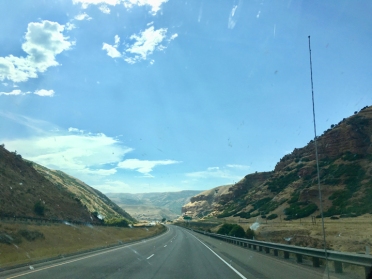Been a few days since I’ve checked in as we continued our Undaunted Courage 2017 Tour up the mountain chain from Salt Lake City into Montana, the main reason being contracting a nasty case of bronchitis.
But I’m feeling well enough to finally make some sense when I write—although I’m sure plenty will contest the fact—so it’s time to get back to recording things before, as happened to the unfortunate Meriwether Lewis, the account of our trip is lost in the mists of history.
The trip north out of Salt Lake got off to a slow, rainy, start since, as it turns out, rush hours in big cities is the same the nation over. As we inched north on I-15 it occurred to me that big city traffic and streetscapes are pretty much the same everywhere we’ve traveled.
But after getting north of the city center, traffic eased considerably as we drove into cattle, mining, and oil country.

Although it was snowing pretty good in Lima, MT, it fortunately wasn’t sticking to the roads as I snapped this shot in the parking lot at Jen’s Cafe & Cabins.
Along about Idaho Falls, we got into what turned out to be a fairly vigorous series of snow squalls that followed us north along the chain. By the time we stopped for lunch at Jen’s Café & Cabins just across the Idaho state line in tiny Lima, Montana, there was about 5” of the stuff on the ground, with more coming down. Definitely a day for hot beef sandwiches. The locals were shaking their heads; Sept. 15 is a mite early for more than a dusting of snow, even in this high country.
Driving ever farther north, we eventually ran out of the snow as we crossed the continental divide twice.
Speaking of undaunted courage, you can’t get away from the redoubtable Lewis and Clark on I-15, passing as you do right by the Clark Canyon Reservoir and Clark’s Lookout State Park. Looking at the landscape as we drove, it wasn’t hard to imagine it as it was when the Corps of Discovery marched through—outside infrequent fences and pumping oil wells, the landscape itself hasn’t changed a whole lot.
At Butte, Montana we picked up I-90, and headed farther up the mountains to Missoula. From there U.S. Route 93 took us right north up to the foot of Flathead Lake and the town of Polson where my childhood buddy Bob and his wife live.
It was definitely cattle and horse country, but it also turned out to be wheat and potato country. Farmers rotate their potato and wheat crops to benefit the soil that’s none too deep in the river valleys where farming is conducted. We drove through just after the wheat harvest had been completed and the order of the day was baling straw, stacking the huge round bales modern machinery creates, and hauling them to market.
Unlike Illinois’ rural areas, local gravel roads are still the norm in the west. In the urbanizing Midwest of northern Illinois we’ve gradually replaced most rural gravel roads with either tar and chip or asphalt-surfaced roads, that are cheaper to maintain and which are more economical for drivers. Blacktopped roads create far less wear and tear on vehicles, and both cars and trucks get far better gas mileage on hard-surfaced roads.
Back in the 1920s when Illinois was considering how best to spend proceeds of a $63 million bond issue voters had approved in 1918, they paid attention to studies carried on concerning fuel efficiency on various road surfaces. In July 1922, Concrete Highway Magazine reported that a road test in Cleveland, Ohio measured fuel efficiency on five 2-ton White trucks loaded to capacity traveling over roads with various surfaces. The trucks averaged nearly 12 miles per gallon of gasoline over concrete roads and 9 mpg on gravel roads.
Driving as we were on a mixture of concrete and asphalt hard roads, I got to wondering about the relative fuel efficiencies of the two surfaces. Especially since concrete roads sometimes create really annoying road noise while asphalt roads are pretty quiet as a rule. I checked out various hypermiling sites on the Net—if you want to find out a bunch of tricks to stretch your gas mileage, the hypermiling guys and gals are your ticket—and the consensus seems to be that the hardest surface provides the best mileage. Period. Asphalt, it turns out, has a softer surface that offers a big of ‘give’ which cuts down on mileage. Not a lit, but a bit.
So up to Polson we drove, arriving when it was a bit cloudy, but where the backdrop was spectacular. Pulling in, Bob happily greeted us as we stretched our legs a bit. “So, what do you think of those?” Bob asked, waiving his hand towards his back pasture.

Home, home on the range where the deer and the yaks play.
We were farm kids together, and his dad kept Brahma bulls that, crazy kids we were, we used to tease with red handkerchiefs, so I was ready to see some prize cattle or horses (Bob’s sort of retired these days, but he’s still an honest-to-God cowboy), but instead I saw a group of short shaggy black animals ambling around out by the pasture’s back fence.
“Nice yaks, don’t you think,” he asked with a little grin.
More later…





 We, on the other hand, started experimenting with cross-continent highways more than a century ago when the
We, on the other hand, started experimenting with cross-continent highways more than a century ago when the 




